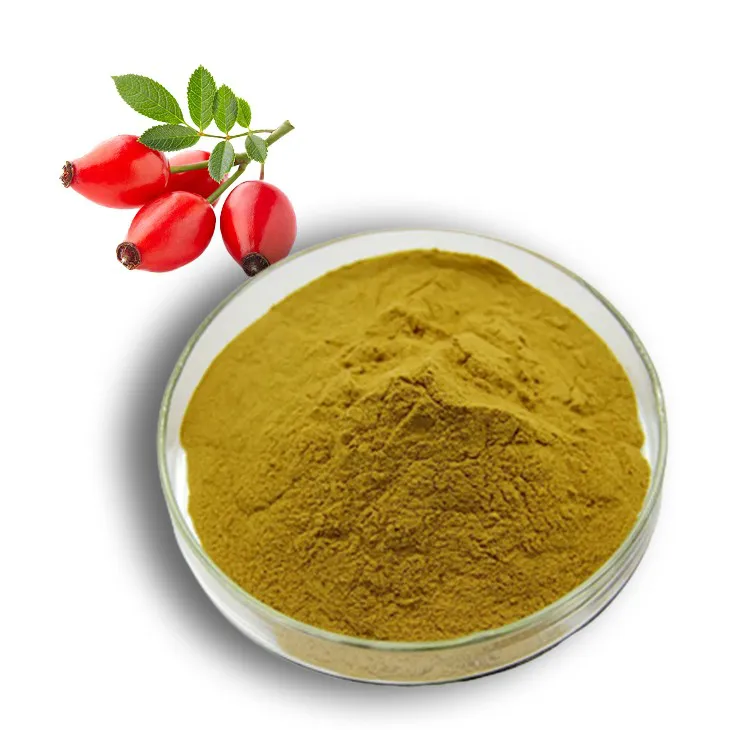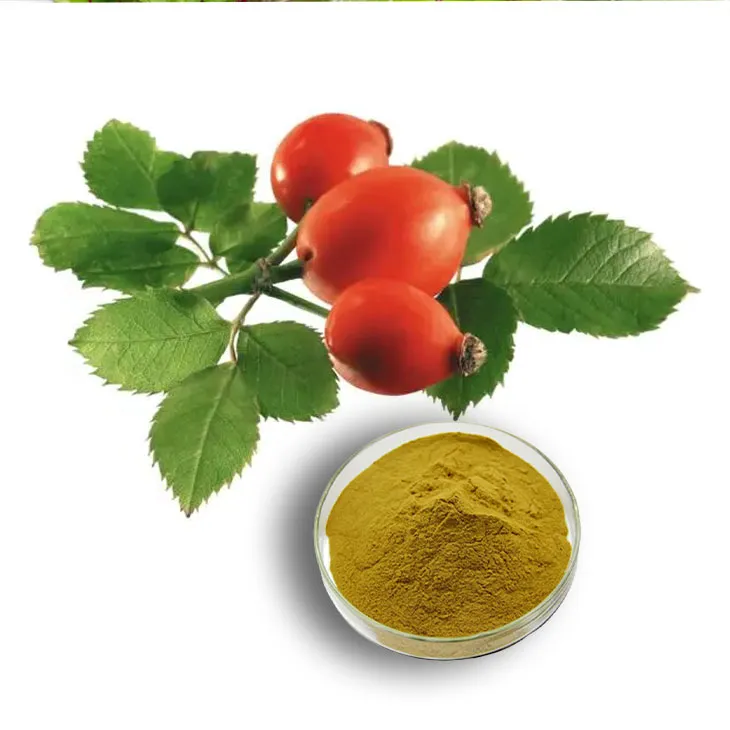- 0086-571-85302990
- sales@greenskybio.com
Extraction technology and production process of rose hip extract.
2024-11-27

1. Introduction
Rosehip extract has attracted significant attention in numerous fields due to its rich nutrient and bioactive substance content. These components endow it with various beneficial properties, making it a valuable ingredient in areas such as cosmetics, pharmaceuticals, and the food industry.

2. Solvent extraction
2.1 Solvent selection
Ethanol and ethyl acetate are commonly used solvents in the extraction of rosehip extract. Ethanol is a popular choice as it is relatively safe, has good solubility for many of the target compounds in rosehips, and is also cost - effective. Ethyl acetate, on the other hand, is often preferred when a more selective extraction of certain hydrophobic compounds is desired. It can effectively dissolve some of the lipophilic bioactive substances present in rosehips.
2.2 Raw material preparation
The production process of rosehip extract using solvent extraction begins with the careful collection and cleaning of rosehips. It is crucial to ensure that only ripe and healthy rosehips are selected. After collection, the rosehips are thoroughly washed to remove any dirt, debris, or contaminants. Subsequently, the cleaned rosehips are dried to reduce their moisture content. This can be achieved through various drying methods such as air drying, oven drying, or freeze - drying, depending on the scale of production and the desired quality of the final product. Once dried, the rosehips are ground into a fine powder. This increases the surface area available for solvent extraction, facilitating a more efficient extraction process.
2.3 Extraction process
The ground rosehip powder is then subjected to solvent extraction. This process is carried out under carefully controlled temperature and time conditions. The temperature needs to be optimized to ensure maximum extraction efficiency without causing degradation of the bioactive substances. For example, in the case of ethanol extraction, a temperature range of around 40 - 60°C is often used. The extraction time also varies depending on factors such as the type of solvent, the nature of the rosehip powder, and the desired extraction yield. Typically, extraction times can range from a few hours to several days. During this process, the solvent penetrates the powder, dissolving the desired compounds from the rosehip matrix.
2.4 Filtration
After the extraction process, the resulting mixture contains both the dissolved rosehip extract and solid residues. Filtration is then carried out to remove these solid residues. Filtration can be achieved using various types of filters, such as filter papers, membrane filters, or filter presses. The choice of filter depends on the scale of production and the desired purity of the extract. For small - scale laboratory extractions, filter papers may be sufficient, while for industrial - scale production, more robust filtration systems like filter presses are often employed.
2.5 Concentration under reduced pressure
The filtered extract still contains a significant amount of solvent. To further purify the extract and obtain a more concentrated form, concentration under reduced pressure is carried out. This process involves reducing the pressure in the system, which in turn lowers the boiling point of the solvent. As a result, the solvent can be evaporated more easily at a lower temperature, without causing damage to the bioactive substances in the extract. Rotary evaporators are commonly used for this purpose in laboratory - scale extractions, while industrial - scale operations may use more specialized vacuum evaporation systems.

3. Supercritical fluid extraction
3.1 Principle of supercritical fluid extraction
Supercritical fluid extraction (SFE) uses carbon dioxide as the supercritical fluid. A supercritical fluid is a substance that is maintained above its critical temperature and critical pressure. Under these conditions, the fluid exhibits properties intermediate between those of a gas and a liquid. Carbon dioxide is an ideal choice for SFE of rosehip extract because it is non - toxic, non - flammable, and has a relatively low critical temperature (31.1°C) and critical pressure (73.8 bar). These properties make it possible to carry out the extraction process under relatively mild conditions, which is beneficial for the preservation of the bioactive substances in rosehips.
3.2 Extraction process
The rosehip material, either in whole or ground form, is placed in an extraction vessel. The carbon dioxide, in its supercritical state, is then passed through the rosehip material. The supercritical carbon dioxide acts as an excellent solvent for many of the bioactive substances in rosehips. The extraction process is also controlled by parameters such as temperature, pressure, and flow rate of the supercritical fluid. For example, increasing the pressure generally improves the solubility of the target compounds in the supercritical carbon dioxide, while adjusting the temperature can also affect the selectivity of the extraction. The extraction time also needs to be optimized to achieve a high - quality extract.
3.3 Advantages of supercritical fluid extraction
One of the main advantages of SFE is the high purity of the extract obtained. Since carbon dioxide is easily removed from the extract by simply reducing the pressure, there is no need for complex and potentially contaminating post - extraction separation steps as in solvent extraction. Moreover, SFE is an environmentally friendly extraction method. Carbon dioxide is a natural gas, and its use as a supercritical fluid does not produce harmful emissions or residues. In addition, the mild extraction conditions in SFE can help to preserve the integrity of the bioactive substances in rosehips, resulting in an extract with higher biological activity.

4. Quality control in rosehip extract production
4.1 Raw material quality control
Quality control in rosehip extract production starts with the raw materials. The source and quality of rosehips need to be carefully monitored. This includes ensuring that the rosehips are collected from areas free from pollution and pesticides. The variety of rosehips also plays a role, as different varieties may have different nutrient and bioactive substance profiles. Only high - quality rosehips should be used in the production process to ensure the quality of the final extract.
4.2 Process control
Throughout the production process, strict process control is essential. In solvent extraction, parameters such as solvent concentration, extraction temperature, time, and filtration and concentration conditions need to be closely monitored and controlled. In supercritical fluid extraction, factors like temperature, pressure, and flow rate of the supercritical fluid must be maintained within the optimal range. Any deviation from the set parameters can affect the quality and yield of the extract. Regular calibration of equipment used in the production process is also necessary to ensure accurate and reliable operation.
4.3 Final product quality assessment
Once the rosehip extract is produced, it needs to undergo final product quality assessment. This includes analysis of its chemical composition to ensure that it contains the expected levels of nutrients and bioactive substances. Tests for purity, such as the detection of residual solvents or contaminants, are also carried out. Microbiological tests are essential to ensure that the extract is free from harmful microorganisms. In addition, the stability of the extract over time needs to be evaluated, especially if it is intended for long - term storage or use in products with a long shelf - life.
5. Conclusion
The extraction technology and production process of rosehip extract are complex and require careful consideration of various factors. Solvent extraction and supercritical fluid extraction are two main methods, each with its own advantages and limitations. Quality control at every step of the production process is crucial to ensure the stability and effectiveness of the final rosehip extract product. As the demand for natural and bioactive - rich ingredients continues to grow, the development and optimization of rosehip extract production processes will be of increasing importance in various industries.
FAQ:
What are the common solvents used in solvent extraction of rosehip extract?
Ethanol and ethyl acetate are the common solvents used in the solvent extraction of rosehip extract.
Why is supercritical fluid extraction considered environmentally friendly in rosehip extract production?
Supercritical fluid extraction uses carbon dioxide as the supercritical fluid. Carbon dioxide is a natural gas that is non - toxic, non - flammable and leaves no harmful residues, so it is considered environmentally friendly in rosehip extract production.
What is the importance of drying rosehips before grinding in the production process of rosehip extract?
Drying rosehips before grinding helps to reduce the moisture content. This can prevent the growth of microorganisms during the production process, and also make the grinding process easier and more efficient, which is beneficial for the subsequent extraction steps.
How does filtration contribute to the production of rosehip extract?
Filtration is used to remove solid residues after solvent extraction. By removing these residues, it can improve the purity of the extract and ensure the quality of the final product.
What are the key aspects of quality control in rosehip extract production?
The key aspects of quality control in rosehip extract production include ensuring the quality of raw materials (rosehips), controlling the extraction process parameters such as temperature, time and solvent ratio accurately, and monitoring the purity and effectiveness of the final extract through various analytical methods.
Related literature
- Rosehip Extract: Properties, Applications and Production"
- "Advanced Extraction Technologies for Rosehip Bioactive Compounds"
- "Quality Assurance in Rosehip Extract Manufacturing"
- ▶ Hesperidin
- ▶ Citrus Bioflavonoids
- ▶ Plant Extract
- ▶ lycopene
- ▶ Diosmin
- ▶ Grape seed extract
- ▶ Sea buckthorn Juice Powder
- ▶ Fruit Juice Powder
- ▶ Hops Extract
- ▶ Artichoke Extract
- ▶ Mushroom extract
- ▶ Astaxanthin
- ▶ Green Tea Extract
- ▶ Curcumin
- ▶ Horse Chestnut Extract
- ▶ Other Product
- ▶ Boswellia Serrata Extract
- ▶ Resveratrol
- ▶ Marigold Extract
- ▶ Grape Leaf Extract
- ▶ New Product
- ▶ Aminolevulinic acid
- ▶ Cranberry Extract
- ▶ Red Yeast Rice
- ▶ Red Wine Extract
-
Cassia Seed Extract
2024-11-27
-
Green coffee bean Extract
2024-11-27
-
Purple Sweet Potato Extract
2024-11-27
-
Clove Powder
2024-11-27
-
Aguaje Extract
2024-11-27
-
Mulberry leaf Extract
2024-11-27
-
Reishi mushroom extract
2024-11-27
-
Mangosteen extract powder
2024-11-27
-
Pueraria Lobata Extract
2024-11-27
-
Golden Seal Extract
2024-11-27





















